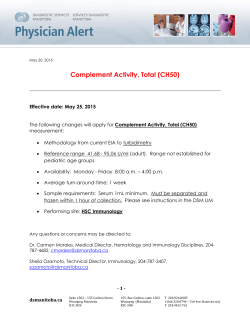
Issues Relating to Anticoagulant Management and Use of APTT
October 1, 2013 Issues Relating to Anticoagulant Management and Use of APTT Testing Consensus Working Group 2013 A number of issues relating to anticoagulation monitoring and management are arising in Manitoba, particularly in smaller sites. Diagnostic Services Manitoba has consulted with experts and stakeholders to help provide direction and clarification relating to these issues. This endeavor is to assist physicians, nurses, hospital administrators, pharmacists and laboratory staff to provide the best care within practical constraints. This statement addresses a few of the ongoing issues; particularly focusing on the aPTT test and alternatives to the use of intravenous unfractionated heparin. aPTT Testing and Therapeutic Range for Heparin Intravenous therapeutic doses of unfractionated heparin (full anticoagulant doses, such as are used for the initial treatment of venous thromboembolism) have conventionally been monitored, and doses adjusted, according to the aPTT test. Both heparin, and the reagents used to perform the aPTT, are complex biological products with lot-to-lot variability, and therefore it is important from time to time to validate the ranges reported by the laboratory. Accreditation requirements have changed the method that must be used for establishing a therapeutic range for unfractionated heparin. Whereas formerly the range could be determined by spiking of plasma samples ex vivo, it is now required to establish the range by regression analysis of the aPTT versus the measured drug level in the blood of heparin-treated patients. This process requires a large number of heparin-treated patients, and is only feasible to perform in the two largest hospitals in Manitoba, the HSC and SBGH. Other sites within the Winnipeg Regional Health Authority, and larger ‘hub’ DSM laboratory sites elsewhere in Manitoba, use the same aPTT reagents and similar laboratory instruments, so the results are applicable to those sites. However, it is not feasible to report therapeutic ranges for heparin at all laboratories. The memo from the Hematology Discipline DSM, from November 14, 2012, outlines many of the laboratory issues. The implication of this change is that at smaller sites the aPTT assay will not be suitable for heparin monitoring, and patients at these sites will not be able to be safely treated with i.v. unfractionated heparin. Additional Challenges with Use of I.V. Heparin In patients suffering from acute thrombosis, it is important to achieve therapeutic anticoagulation quickly to reduce the risk of further thrombosis and pulmonary embolism. In an audit from implementation of the WRHA’s heparin nomogram for acute coronary syndromes, the major determinant of the time to reach therapeutic anticoagulation was ensuring that aPTTs were collected and analyzed in a timely manner. dsmanitoba.ca Suite 1502 – 155 Carlton Street Winnipeg, Manitoba R3C 3H8 ‐1‐ 155, Rue Carlton, suite 1502 Winnipeg (Manitoba) R3C 3H8 T 204.926.8005 1.866.320.8796 – Toll‐free Manitoba only F 204.940.1761 Time to Endpoint (hrs) Q6h aPTT Until WT (n = 35) Lacking q6h aPTT (n = 11) Significance Time to Therapeutic (mean) 9.1 + 5.0 18.1 + 17.5 P < 0.01 Time to Target (mean) 10.8 + 5.7 29.0 + 17.7 P < 0.00001 Realistically, 24/7 laboratory testing and analysis is required to achieve a satisfactory, timely endpoint with i.v. unfractionated heparin. Moreover, anticoagulants such as i.v. heparin are considered ‘high risk’ medications. The narrow therapeutic index, the need for continuous i.v. infusion, frequent monitoring and dose adjustment makes its use relatively complex. If used infrequently, it becomes difficult to ensure the familiarity and expertise needed for effective and safe therapy. Fortunately, alternatives equivalent to or superior to i.v. unfractionated heparin are available. Indeed, with the advent of low molecular weight heparins (enoxaparin, tinzaparin, and dalteparin), fondaparinux, and now new oral anticoagulants (dabigatran, rivaroxaban, and apixaban), the use of i.v. unfractionated heparin has declined dramatically over the past 20 years. Today, infusions of i.v. unfractionated heparin are primarily used in patients with severe renal failure. A creatinine clearance (Clcr) of less than 30 mL/min is usually used as the cut-off to use unfractionated heparin in place of a low molecular weight heparin. Anticoagulation Management Challenges in Renal Failure for Rural Centers Taking all of the above issues into consideration, and after discussion with representatives of Hematology, Cardiology, Nephrology and Pharmacy, we recommend that the safest and most efficacious choice of anticoagulation of venous thromboembolism and acute coronary syndromes for most smaller sites in patients with renal failure (defined in this setting as a Clcr < 30 mL/min calculated by either EGFR or Cockroft-Gault) is with enoxaparin 1 mg/kg once daily rather than with i.v. unfractionated heparin. In patients of high body mass, the maximum enoxaparin dose for treatment with venous thrombosis should be 150mg. For acute coronary syndromes, please refer to specific dosing recommendations from the WRHA Cardiac Sciences Program. These recommendations will be posted in the “For Prosessionals” section of their website: www.umanitoba.ca/faculties/medicine/units/cardiac_sciences/forprofessionals.htm Enoxaparin is approved for use in severe renal impairment in Canada for both acute coronary thromboembolism. syndromes and venous dsmanitoba.ca Suite 1502 – 155 Carlton Street Winnipeg, Manitoba R3C 3H8 ‐2‐ 155, Rue Carlton, suite 1502 Winnipeg (Manitoba) R3C 3H8 T 204.926.8005 1.866.320.8796 – Toll‐free Manitoba only F 204.940.1761 For larger sites that continue to use i.v. infusions of unfractionated heparin, it is recommended that they use the WRHA’s heparin nomograms. Separate nomograms are available for management of acute coronary syndromes and venous thromboembolism. DSM will continue to work in collaboration with the Hemostasis Disorders Comprehensive Care Team to these nomograms are referenced against a therapeutic range determined for each new lot of aPTT reagents. Any changes in the nomogram will be communicated to sites in a timely manner. Use of the aPTT as a Diagnostic and Screening Test Clinicians are reminded that the aPTT test has very limited utility as a diagnostic test, since a normal value does not rule out the presence of important disorders of hemostasis, and false positives are common. Patients suspected on the basis of their history of having defects of hemostasis should be referred for comprehensive assessment. The aPTT should not be used as a screening test pre-operatively in asymptomatic subjects. Hence, the potential unavailability of the aPTT at smaller sites should have little impact on clinical practice. Participants Dr. Carmen Morales (Medical Director, Hematology, DSM MB) Dr. Sara Israels (Pediatric Hematology, Hemostasis Lab Director) Drs. Charles Musuka and Ping Sun (Hematopathology, DSM MB) Mrs. Gail Turnbull (Technical Director, Hematology, DSM MB) Dr. Don Houston (Section Director, Adult Hematology) Dr. Peter Thomson (WRHA Pharmacy Program) Dr. James Tam (WRHA Cardiac Sciences Program) Drs. Joe Buetti, Lori Wazny & James Zacharias (MB Renal Program) dsmanitoba.ca Suite 1502 – 155 Carlton Street Winnipeg, Manitoba R3C 3H8 ‐3‐ 155, Rue Carlton, suite 1502 Winnipeg (Manitoba) R3C 3H8 T 204.926.8005 1.866.320.8796 – Toll‐free Manitoba only F 204.940.1761
© Copyright 2025












